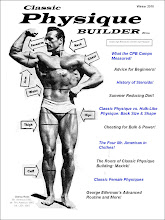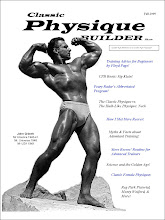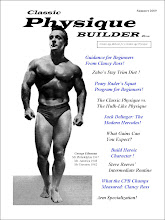
(Above: Steve Reeves doing incline presses)
In a previous post, we discussed Steve Reeves' beginning workout routine (click on the sidebar label "beginning workout routine"). It was a routine that he put together, at the age of 16 (in 1942), after doing a lot of reading in magazines such as Bob Hoffman's Strength and Health. Steve said that it was a good routine and that he gained about 8 pounds on it in about 4 months.
After that, Steve started to train in Ed Yarick's Gym in Oakland, CA. This was one of the premier gyms on the West Coast in the early 1940s. Ed put Steve on an intermediate workout routine that Steve called his "Second Workout Schedule." In just four months on this routine under Ed's supervision, Steve gained 30 pounds!
Now, we must remember that Steve was 16 and so he had a lot of natural, high levels of testosterone circulating in his system. Under Ed's supervision, he was also resting and eating properly. But, that being said, this is a great, full body routine of 14 exercises that can produce results in a short period of time for the intermediate classic physique builder!
Here is the routine (amwp = as much weight as possible):
Warm-Up: Dumbbell Swings Exercises
1. Upright Rowing - 3 sets, 15-20 reps (use moderate weight)
2. Bench Press - 3 sets, 8-12 reps (amwp)
3. 1 Arm Dumbbell Rows - 3 sets, 8-12 reps (amwp)
4. Dumbbell Flyes - 3 sets, 8-12 reps (amwp)
5. Incline Press - 3 sets, 8-12 reps (decreasing weight each set)
6. Triceps Pushdowns - 3 sets, 8-12 reps (amwp)
7. Barbell Curls - 3 sets, 8-12 reps (amwp)
8. Seated Dumbbell Curls - 3 sets, 8-12 reps (amwp)
9. Full Squats - 3 sets, 8-12 reps (amwp)
superset with:
10. Pullovers - 3 sets, 8-12 reps (amwp)
11. Breathing Squats - 1 set, 20 reps (amwp)
superset with:
12. Breathing Pullovers - 1 set 20 reps (amwp)
13. Deadlifts, 2 sets, 8-12 reps (amwp)
14. Good Mornings - 2 sets, 8-12 reps (amwp)
So there you have it! This is a full body routine that Steve followed 3 days a week (e.g., M, W, and F). Today, there is scientific research that shows that exercises such as squats release a substantial amount of testosterone. So doing a full body routine with squats can result in an extra boost of growth for the entire body. In the Golden Age of Classic Physique Building (the 1940s and 50s), they didn't have this research, but they knew this from their own training experience. Certainly, Steve made great gains on this routine in 4 months!
For complete exercise descriptions and other insights into his training, see Steve's book Building the Classic Physique the Natural Way which is available through the Steve Reeves International Society at http://www.stevereeves.com/. It is a great book that we highly recommend.
We report Steve's intermediate routine - without any changes - for historical purposes. This is indeed the routine that he actually followed. However, CPB does not recommend doing the "Good Morning" exercise because we feel it is too easy to get injured. We believe Steve's routine would be just fine if this one exercise were dropped.
This isn't the only type of intermediate training schedule that we find in the Golden Age. There are many other routines. However, this one certainly worked for Steve. So if you are an intermediate classic physique builder, perhaps it can work for you as well! - CPB







9 comments:
Hello CPB,
On the way to your blog spot I happened to click on a site that had old films of Steve Reeves doing his posing routine. I had only seen still photos. It was impressive. Some others were posing too. They posed differently then, more graceful, more classic, but very manly.
Appreciated your latest post.
Thanks.
Brendon
Hi Brendon,
Yes...the posing was different in the Golden Age. It was more classic and even "heroic" in nature - because the Golden Age Champs identified with the heros and gods of Ancient Greece and Rome. There was none of the grimacing or growling and agressive-style of posing by today's mainstream bodybuilders who often identify with cartoons, freaks/mutants, and/or monsters. The Golden Age of Classic Physique Building (the 1940s and 50s) was truly a different world - CPB
Hi CPB,
I have almost been training a year now but i've never done fully body workouts three days a week. What do you guys think would be more logical starting off at the intermediate level or beginning level of Steve's routine's? I was thinking about beginner but one set doesn't really seem like enough. Your opinion will be greatly appreciated.
Hi Matt,
It is a little hard for us to make a recommendation since we don't know exactly what you have been doing for your 1st year. But we can say this. If, for your first year, you have not been following a proper, systematic muscle building course (but instead training without real instruction or making any significant gains), then we would recommend starting with the Reeve's beginning routine.
If, however, you have followed some systematic course for your first year and have made significant gains, then you could start with his intermediate routine.
In any case, don't be fooled by the low volume of 1 or 2 sets! Think of this as a HIT (High Intensity Training) type of routine. We haven't really mentionned this before (and we will do an article on this in our next issue of CPBzine), but Steve trained with very high intensity. For every set (whether it was one or two or three sets), he trained to failure (or almost failure).
In other words, if his routine called for doing 8 reps, then he picked a weight that he could not do more than 8 reps with (so he is really forcing out that last rep on the first set). Then, over the next few workouts, he would try to increase the reps until he could do 12 reps. Once he could reach 12 reps, he knew he was strong enough to increase the weight at his next workout. By increasing the weight, he would again fail at 8 reps and then he would repeat the process of increasing the reps over time to 12, etc.
This (training to failure) is quite similar to the HIT approach of Arthur Jones and Mike Mentzer - who advocated doing one set to failure. They believed that this really kicked the growth mechanism into high speed. Now Steve did one set as a beginner, and then went to 2 sets and then 3 sets as an intermediate and advanced trainer. But, as we said, don't be fooled! If he did one set, he got everything he could out of it with his high intensity approach! He did train to failure or almost complete failure (it wasn't exactly like Mike Mentzer's HIT approach because Steve did more than one set after he was a beginner - but we are drawing the comparison to highlight the importance of intensity).
So whichever routine you choose, intensity is a key factor in its success.
Also, we should mention that 3 day a week, full body routines were a standard of Golden Age training for beginners (and even intermediate and advanced trainers from 1940-53). However, everyone is different - especially when it comes to energy and muscle recovery time. So if you try the 3 day a week schedule and find that your muscles just aren't recovering before the next workout (you can tell this if you don't get progressively stronger, but instead stay at a standstill or get progressively weaker in your poundages), then you will have to make adjustments to accomodate your own biology. In that case, you can train every 4th day - with 2 full days of rest between every workout or simply train twice a week instead of 3 times.
Also, Steve would rest between sets just long enough to catch his breath or let his training partner finish his set, and then he would do his next set (so no goofing around, talking, breaking concentration, etc). Think about how long it takes to do a set of 10 reps - not very long. So he would rest no longer than that between sets (no more than 45 seconds - so keep a watch with you!). However, he would rest up to 5 minutes between body parts. This really helps in keeping your energy up for these high intensity, full body workouts!
One final thing, Steve believed in "getting the negative" out of every rep. So the positive phase of an exercise would take him 2 seconds, and he would take 3 seconds for the negative phase.
If you incorporate all these factors into your full body workout, you will find even one set pretty demanding we think!
In any case, these are some things to think about as you make your decision.
We hope this helps!
CPB
Thanks a lot for your help. I think Im going to start off fresh at the beginner stage and work my way up from there. Also, I just finished reading Steve's book and I found it one of the best Bodybuilding books I've read. No complicated techniques, very straight forward, yet very logical. Its amazing that in three months of proper training and etc, he was able to gain close to 30 pounds. An inspiration to all us natural guys!
Oh and one more thing. If you are doing one set per body part would you rest 45 secs after the set and go to the next body part or rest 3-5 minutes and then, go to the next body part?
Hi Matt,
Yes...we highly recommend Steve's book "Building the Classic Physique the Natural Way"! It has great info and is very inspirational!
With his Golden Age training techniques, he was able to gain an incredible amount of muscle mass in a short period of time. But, also keep in mind, he was 16 and so he was at the age when there is potential for a lot of quick growth. But even so, if he had trained incorrectly, he would not have made those gains - so Golden Age methods really work!
If you are doing one set, then 3 minutes should be fine. But keep your eye on the clock so you can learn how your body responds under specific conditions. We can't tell you how many people we've seen in gyms carrying on 10 minute conversations between sets and yet they expect to make gains?!
All the best (and keep us posted as to your progress)!
CPB
i think their is one thing that gets missed in your columns is that the Golden era bodybuilders did a lot of gymnastics training on their days off...that alone is one heck of a workout...John Grimek told me when he wasn't lifting he was doing hand stands and gymnastics training...I ask anyone of your readers that on their offdays do a pile of chinups, pushups, and hand stands and see how they feel the next day
When did he work calves and ABS?
Post a Comment